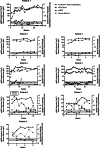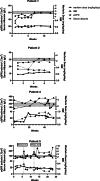Thromboprophylaxis in congenital nephrotic syndrome: 15-year experience from a national cohort
- PMID: 33089377
- PMCID: PMC8009789
- DOI: 10.1007/s00467-020-04793-z
Thromboprophylaxis in congenital nephrotic syndrome: 15-year experience from a national cohort
Abstract
Introduction: Congenital nephrotic syndrome (CNS) is an ultra-rare disease associated with a pro-thrombotic state and venous thromboembolisms (VTE). There is very limited evidence evaluating thromboprophylaxis in patients with CNS. This study aimed to determine the doses and duration of treatment required to achieve adequate thromboprophylaxis in patients with CNS.
Methods: From 2005 to 2018 children in Scotland with a confirmed genetic or histological diagnosis of CNS were included if commenced on thromboprophylaxis. The primary study endpoint was stable drug monitoring. Secondary outcomes included VTE or significant haemorrhage.
Results: Eight patients were included; all initially were commenced on low-molecular weight heparin (enoxaparin). Four patients maintained therapeutic anti-Factor Xa levels (time 3-26 weeks, dose 3.2-5.07 mg/kg/day), and one patient developed a thrombosis (Anti-Factor Xa: 0.27 IU/ml). Four patients were subsequently treated with warfarin. Two patients maintained therapeutic INRs (time 6-11 weeks, dose 0.22-0.25 mg/kg/day), and one patient had two bleeding events (Bleed 1: INR 6, Bleed 2: INR 5.5).
Conclusions: Achieving thromboprophylaxis in CNS is challenging. Similar numbers of patients achieved stable anticoagulation on warfarin and enoxaparin. Enoxaparin dosing was nearly double the recommended starting doses for secondary thromboprophylaxis. Bleeding events were all associated with supra-therapeutic anticoagulation.
Keywords: Anticoagulation; Infantile nephrotic; Low molecular weight heparin; Venous thromboembolism; Warfarin.
Conflict of interest statement
The authors declare that they have no conflict of interest.
Figures


Similar articles
-
Anti-Xa-guided enoxaparin thromboprophylaxis reduces rate of deep venous thromboembolism in high-risk trauma patients.J Trauma Acute Care Surg. 2016 Dec;81(6):1101-1108. doi: 10.1097/TA.0000000000001193. J Trauma Acute Care Surg. 2016. PMID: 27488490
-
Retrospective comparison of low molecular weight heparin vs. warfarin vs. oral Xa inhibitors for the prevention of recurrent venous thromboembolism in oncology patients: The Re-CLOT study.J Oncol Pharm Pract. 2018 Oct;24(7):494-500. doi: 10.1177/1078155217718382. Epub 2017 Jul 16. J Oncol Pharm Pract. 2018. PMID: 28714376
-
Association of Anti-Factor Xa-Guided Dosing of Enoxaparin With Venous Thromboembolism After Trauma.JAMA Surg. 2018 Feb 1;153(2):144-149. doi: 10.1001/jamasurg.2017.3787. JAMA Surg. 2018. PMID: 29071333 Free PMC article.
-
Venous thromboembolism in cancer patients.Hosp Pract (1995). 2014 Dec;42(5):24-33. doi: 10.3810/hp.2014.12.1156. Hosp Pract (1995). 2014. PMID: 25485915 Review.
-
Apixaban: A Review in Venous Thromboembolism.Drugs. 2016 Oct;76(15):1493-1504. doi: 10.1007/s40265-016-0644-6. Drugs. 2016. PMID: 27653758 Review.
Cited by
-
Managing venous thrombosis in a pediatric patient with short bowel and congenital nephrotic syndromes: a case report emphasizing rivaroxaban level monitoring.Front Pediatr. 2024 Apr 3;12:1385065. doi: 10.3389/fped.2024.1385065. eCollection 2024. Front Pediatr. 2024. PMID: 38633324 Free PMC article.
-
Secondary congenital nephrotic syndrome complicated by acute mesenteric ischemia: A case report.Clin Nephrol Case Stud. 2025 Mar 3;13:13-17. doi: 10.5414/CNCS111438. eCollection 2025. Clin Nephrol Case Stud. 2025. PMID: 40070415 Free PMC article.
-
Childhood nephrotic syndrome and the clinical profile of thromboembolism: a systematic review and meta-analysis.Pediatr Res. 2023 May;93(6):1463-1469. doi: 10.1038/s41390-022-02302-6. Epub 2022 Sep 20. Pediatr Res. 2023. PMID: 36127405

